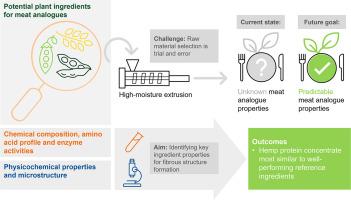表征豆科和油籽蛋白浓缩物的组成和理化性质,以评价其在高水分挤压加工中的潜力
IF 8.2
Q1 FOOD SCIENCE & TECHNOLOGY
引用次数: 0
摘要
本研究代表了一个更大的实体评估豌豆、蚕豆、亚麻籽和大麻籽植物蛋白浓缩物在高水分挤压加工(HMEP)中的适用性的初始阶段,其中分析了成分的化学成分和功能特性。以小麦面筋和豌豆分离蛋白为基准原料。主要的重点是在HMEP中产生纤维结构的潜在重要特性,尽管也分析了可能影响挤出物营养质量和风味的特定化合物和内源性酶的水平。不同成分之间存在显著差异,大麻与分离蛋白在高蛋白质含量、低膳食纤维含量和低蛋白质可提取性方面最为相似。亚麻与大麻相当,但蛋白质含量较低。豆科浓缩物的高蛋白质提取率可能成为其在HMEP中应用的障碍。某些成分中存在的植酸、棉子糖家族低聚糖和脂质修饰酶水平升高需要缓解HMEP。这项研究的发现将作为后续调查的基础,这些新兴成分的性能将在实际的HMEP试验中进行评估。本文章由计算机程序翻译,如有差异,请以英文原文为准。

Characterising the composition and physicochemical properties of legume and oilseed protein concentrates to evaluate their potential for high-moisture extrusion processing
This study represents the initial phase of a larger entity evaluating the applicability of plant protein concentrates from pea, faba bean, flaxseed, and hempseed for high-moisture extrusion processing (HMEP), in which chemical composition and functional properties of the ingredients were analysed. Wheat gluten and pea protein isolate were used as benchmark ingredients. The main emphasis was on properties potentially important for creating fibrous structures in HMEP, although the levels of specific chemical compounds and endogenous enzymes that might influence the nutritional quality and flavour of the extrudates were also analysed. Significant variation was observed among the ingredients, with hemp showing the most similarities to protein isolates in terms of high protein content, low dietary fibre content, and low protein extractability. Flax was comparable to hemp but had a lower protein content. The high protein extractability of legume concentrates may be a barrier for their application in HMEP. The presence of elevated levels of phytic acid, raffinose family oligosaccharides, and lipid-modifying enzymes in certain ingredients need mitigation for HMEP. The findings of this study will serve as a foundation for a subsequent investigation, where the performance of these emerging ingredients will be evaluated in actual HMEP trials.
求助全文
通过发布文献求助,成功后即可免费获取论文全文。
去求助
来源期刊

Future Foods
Agricultural and Biological Sciences-Food Science
CiteScore
8.60
自引率
0.00%
发文量
97
审稿时长
15 weeks
期刊介绍:
Future Foods is a specialized journal that is dedicated to tackling the challenges posed by climate change and the need for sustainability in the realm of food production. The journal recognizes the imperative to transform current food manufacturing and consumption practices to meet the dietary needs of a burgeoning global population while simultaneously curbing environmental degradation.
The mission of Future Foods is to disseminate research that aligns with the goal of fostering the development of innovative technologies and alternative food sources to establish more sustainable food systems. The journal is committed to publishing high-quality, peer-reviewed articles that contribute to the advancement of sustainable food practices.
Abstracting and indexing:
Scopus
Directory of Open Access Journals (DOAJ)
Emerging Sources Citation Index (ESCI)
SCImago Journal Rank (SJR)
SNIP
 求助内容:
求助内容: 应助结果提醒方式:
应助结果提醒方式:


